The aquatic realm is home to over 33,000 species of fish, but how many fish start with J? From the vast depths of the ocean to the tranquil waters of freshwater habitats, we will discover a wide variety of fish showcasing an incredible diversity. Embarking on this exploration, we encounter an ensemble of aquatic marvels, each with distinct traits and charm, from all over the world, including Asia, Africa, Central America, SOuith America, North America, Europe, and more.
Fish That Start With J
Jack (Carangoides bartholomaei)
First on our list of fish that start with J is the Jack, or Yellow Jackfish, scientifically known as Carangoides bartholomaei. It is a striking fish species renowned for its streamlined body and vibrant colors. These fish often reside near coral reefs and coastal areas, found primarily in the warm waters of the tropical to subtropical western Atlantic Ocean. They’re skilled predators, utilizing their speed and agility to chase down prey. Moreover, with a diet comprising smaller fish, Jacks play a crucial role in maintaining the ecological balance of their habitat. Their distinctive appearance and active behavior make them a beautiful sight among snorkelers and divers exploring their waters. Furthermore, this species of fish plays an economic importance> it is fished for by hook and net and is considered a fair table fish.

Jackfish often reside near coral reefs and coastal areas. They primarily reside in the warm waters of the tropical to subtropical western Atlantic Ocean.
©raditya/Shutterstock.com
Jackfish (Caranx hippos)
The Jackfish, scientifically labeled as Caranx hippos, is a robust, large, fast-swimming fish inhabiting coastal and offshore waters across reefs, bays, lagoons, and occasionally estuaries. It sports a silvery body and often with distinct dark yellow and blue markings around its fins. And it is recognizable by its deeply forked tail fin. Jackfish reside in the Atlantic Ocean’s tropical and temperate waters. Furthermore, they are carnivorous predators. Their diet consists of smaller fish, squids, and invertebrates, contributing to the delicate balance of marine ecosystems. With their impressive swimming abilities and predatory nature, Jackfish are a sight to behold for marine enthusiasts.

Jackfish are silvery in color. They are robust and fast-swimming fish inhabiting coastal and offshore waters across reefs, bays, and lagoons.
©Florian Scuba/Shutterstock.com
Jack Dempsey (Rocio octofasciata)
The Jack Dempsey, scientifically referred to as Rocio octofasciata, is a charismatic freshwater fish native to the waters from southern Mexico to Honduras. They are an introduced species in Australia, the United States, and Thailand. Recognizable by its vivid coloration and intricate patterns, this cichlid species is a popular choice for aquarium enthusiasts. Named after the legendary boxer Jack Dempsey due to their aggressive behavior, these fish are known for their territorial nature. Yet they can also be quite shy.
They thrive in freshwater environments with rocky substrates and ample hiding places. They also prefer slow-moving waters. Such freshwater environments include swampy areas with warm, murky water, areas that are weedy, mud-bottomed canals, sand-bottomed canals, drainage ditches, and rivers. Furthermore, they are carnivorous fish. Their diet consists of various foods, including worms, algae, insects, crustaceans, mollusks, crayfish, and even small fish. Due to their vibrant appearance and engaging behavior, Jack Dempseys remain sought-after by aquarists worldwide.
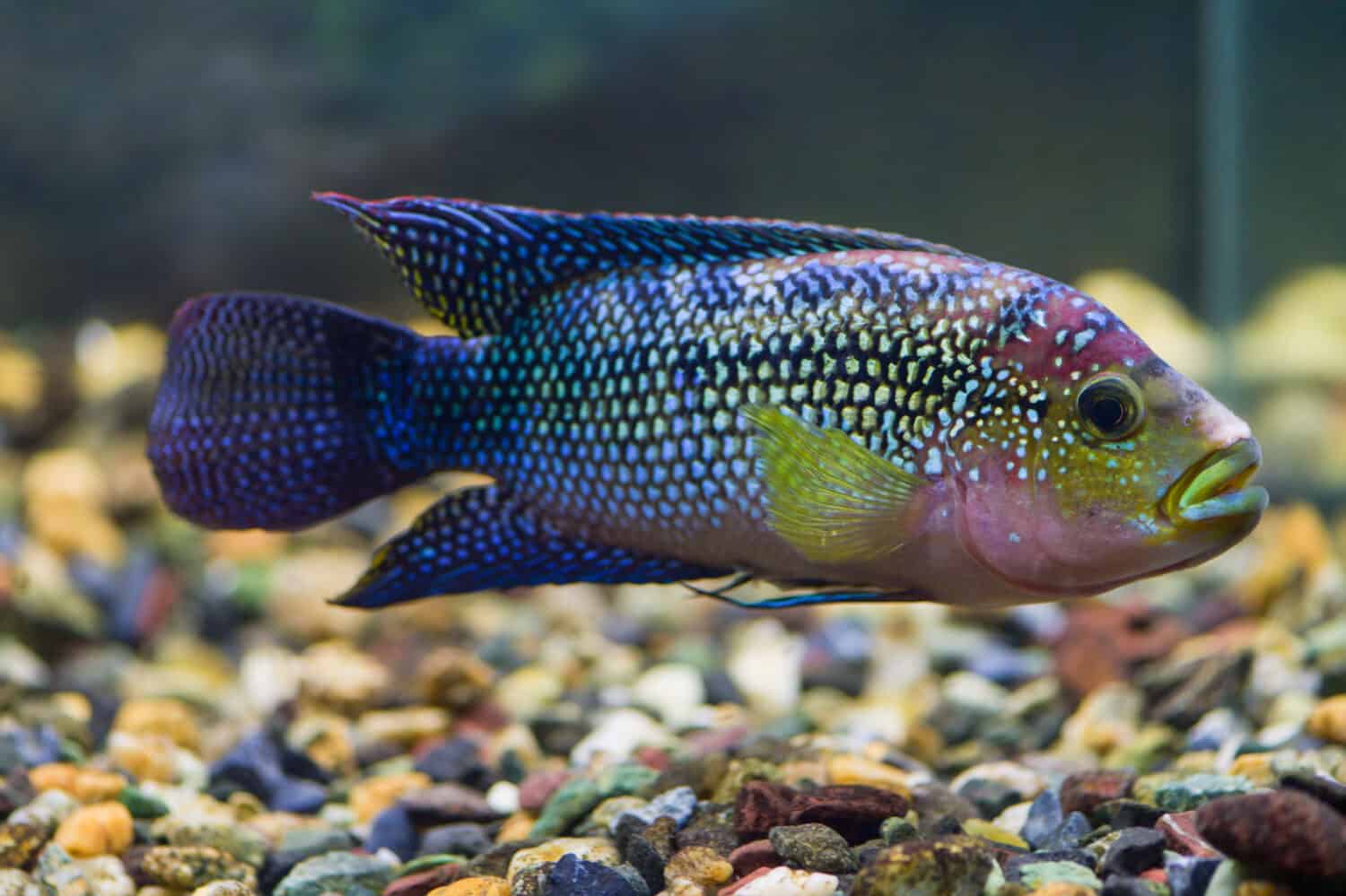
The Jack Dempsey is a freshwater fish native to the waters from southern Mexico to Honduras.
©Bk87/Shutterstock.com
Jae Barb (Enteromius jae)
The Jae Barb, scientifically identified as Enteromius jae, is a captivating small fish species on our list of fish that start with J. It is native to western central Africa’s freshwater rivers and streams, from Cameroon to the Republic of Congo, the Democratic Republic of the Congo, and Gabon. They are renowned for their sleek body and shimmering beige-brown scales across their bodies and red-hued fins, though their colors can vary. This barb species adds a touch of brilliance to its habitat. Jae Barbs are known for their schooling behavior, often gathering in groups for safety and social interaction. They are said to be a micro predator. Thus their diet mainly consists of insect larvae and small crustaceans. Furthermore, their captivating appearance makes Jae Barbs a delightful addition to community aquariums.
Jaguar Cichlid (Parachromis managuensis)
The Jaguar Cichlid, scientifically named Parachromis managuensis, is a striking freshwater fish originating from Central America. This species is a robust fish with colors of silvery-green, golden-green, purple hues, darker green hues, white hues, and yellow hues. Its intricate pattern of dark horizontal spots resembles the majestic coat of a jaguar, earning it its name. As a predatory species, these cichlids exhibit territorial behavior and require spacious aquariums with ample hiding spots. Their diet comprises various prey items, including fish, crustaceans, and insects. Moreover, Jaguar Cichlids are known for their intelligence and ability to recognize their owners, making them popular among dedicated aquarium keepers.
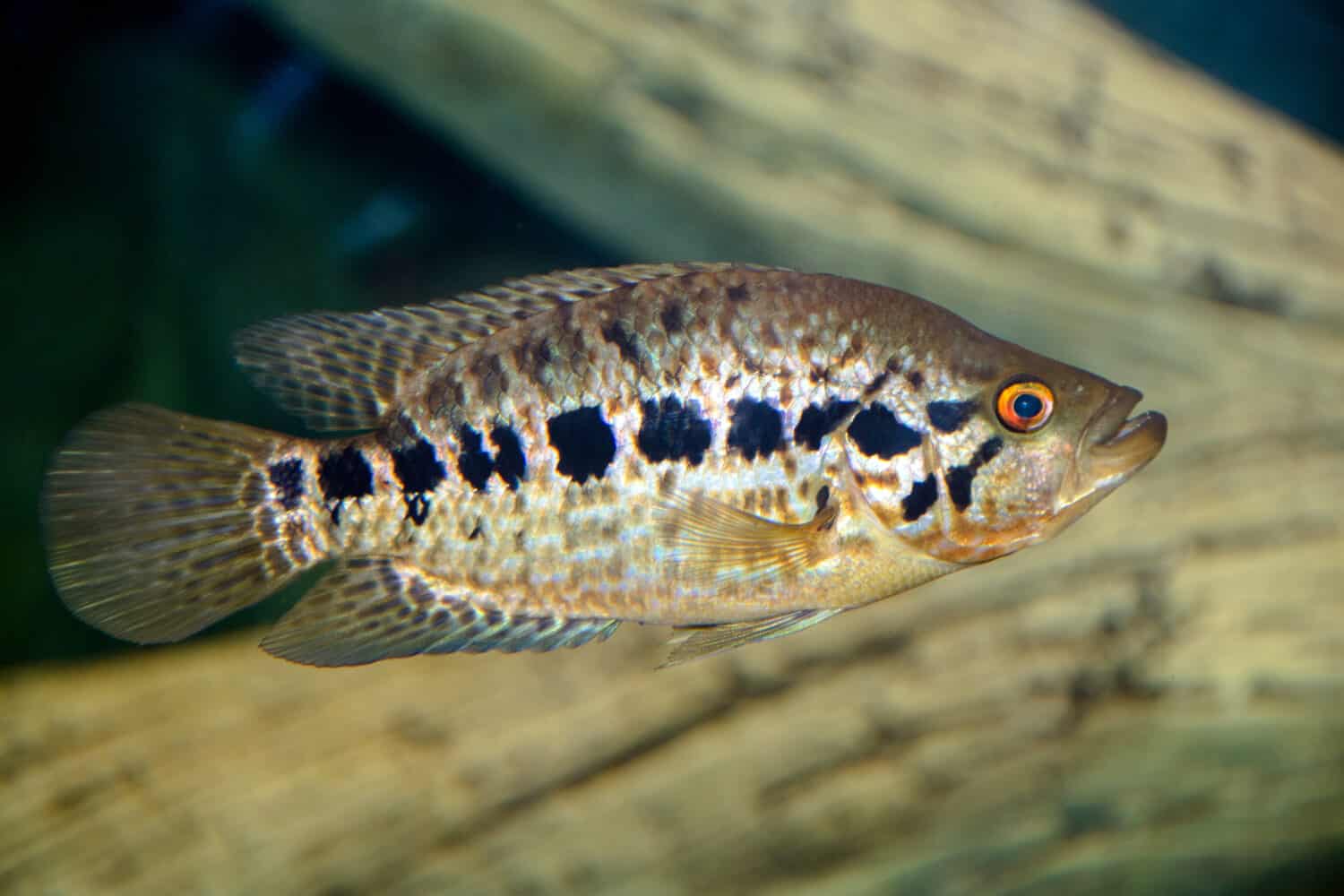
The Jaguar Cichlid’s scientific name is
Parachromis managuensis. It is a freshwater fish originating from Central America.
©Licvin/Shutterstock.com
Jaguar Catfish (Liosomadoras oncinus)
Meet the remarkable Jaguar Catfish, scientifically known as Liosomadoras oncinus. Its striking pattern resembles the majestic jaguar’s coat, adding a touch of the wild to freshwater habitats to its native rivers in Brazil. These nocturnal predators sport long whiskers and sturdy spines for defense. Found in slow-moving waters, they’re masters of camouflage and ambush. It is another carnivorous fish that eats a wide variety of worms, insects, small fish, and more. Moreover, with their unique appearance and intriguing behavior, the Jaguar Catfish plays an essential role in its native aquatic ecosystem, showcasing the beauty of nature’s design.
Janssens’ Barb (Barbus janssensi)
Scientifically known as Barbus janssensi, it is another fish species on our list of fish that start with J. Sporting a shimmering silver body that may have orangish red fins, these barbs reside in freshwater streams and rivers across its native country, the Democratic Republic of Congo. Often seen in fast-flowing waters, they have perfected the art of swift navigation. Furthermore, they are small fish usually found in schools.
Japanese Eel (Anguilla japonica)
The mysterious Japanese Eel’s scientific name is Anguilla japonica. It resides in Japan, Korea, Taiwan, China, Vietnam, and the northern Philippines. Its life cycle spans both freshwater and marine environments. Furthermore, this aquatic wonder embarks on an epic journey, migrating thousands of kilometers from freshwater rivers to the vast expanses of the Pacific Ocean to spawn. Famous for its long and serpentine body, it is an endangered species on the IUCN Red List. It is also raised in aquaculture ponds and is a vital part of Japanese cuisine, making up 95 percent of commercially sold eels in Japan. This eel plays a significant cultural and economic role.

Japanese Eels make up 95 percent of commercially sold eels in Japan, playing a significant cultural and economic role.
©kazoka/Shutterstock.com
Jau Catfish (Zungaro zungaro)
The Jau Catfish’s scientific name is Zungaro zungaro. This massive freshwater catfish, found in the waters of South America, boasts a robust body and a voracious appetite. With their impressive size and sharp spines, they reign as formidable predators. Furthermore, they can grow up to 55 inches in length and weigh up to 110 pounds on average, regularly surprising both of these measurements. As for aquariums, they can also be found in public aquariums or huge tropical ponds. Naturally inhabiting various river systems, these catfish exhibit the raw potency of nature, reminding us of the awe-inspiring diversity within Earth’s waters.
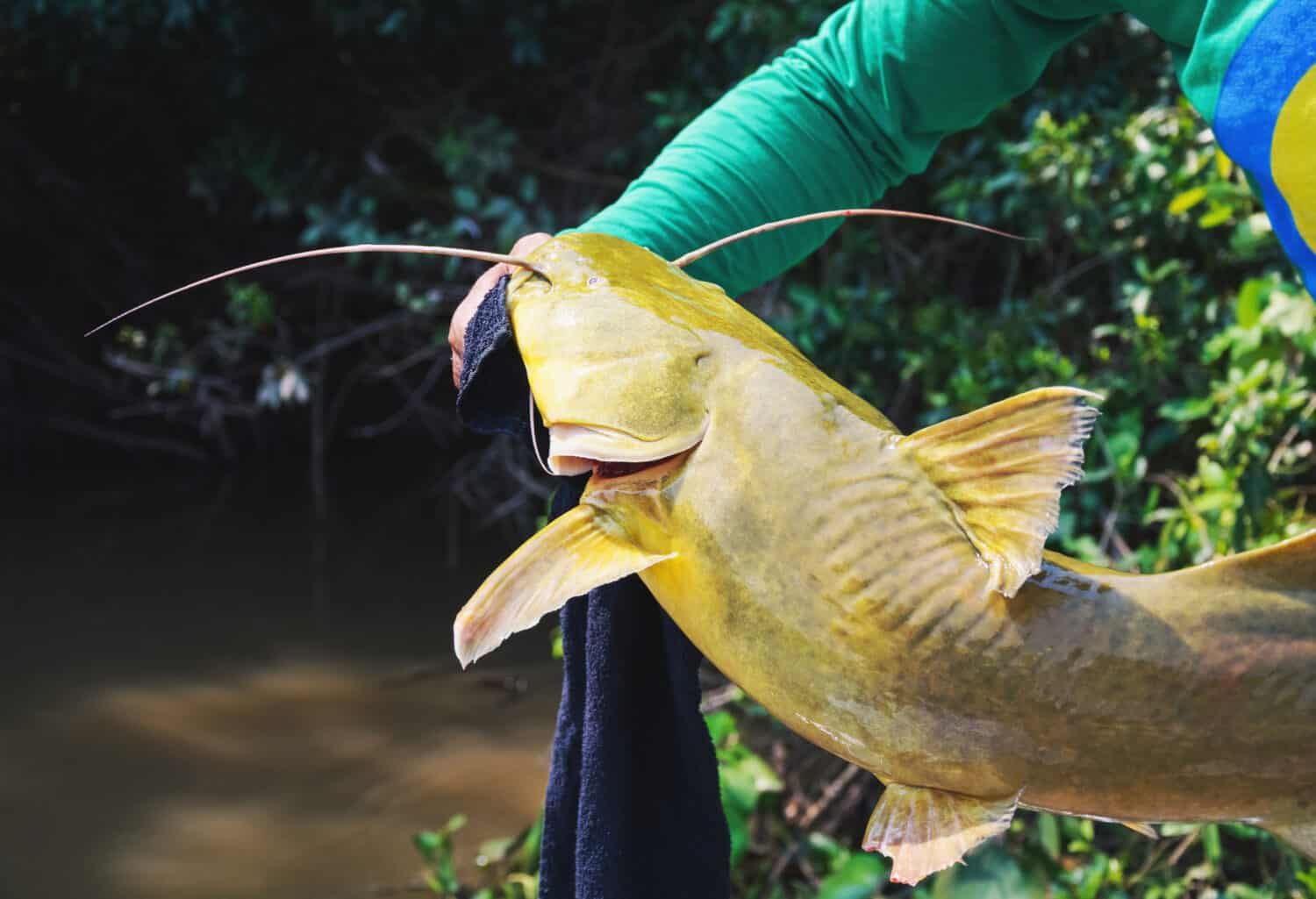
The Jau Catfish can grow up to 55 inches in length and weigh up to 110 pounds or more.
©Vinicius Bacarin/Shutterstock.com
Javelin (Coelorinchus australis)
Another fish on our list of fish that start with J is the Javelin fish, also known as Coelorinchus australis. This species resides in the waters around Australia and New Zealand. This denizen of the abyssal ocean exhibits a streamlined body and specialized adaptations for surviving in cold and dark waters. With its elongated shape and large eyes, the Javelin is well-suited for capturing prey in its mysterious habitat. Its prey consists mainly of octopus, various fish, and decapod crustaceans. It displays a brownish color with multiple pale longitudinal stripes. Moreover, its unique features highlight the astonishing adaptability of life in extreme environments, serving as a reminder of the marvels that lie beneath the surface.
Jawfish (Opistognathus aurifrons)
The Jawfish’s scientific name is Opistognathus aurifrons. They inhabit coral reefs in tropical waters and are native to the Caribbean Sea. Moreover, their heads and upper bodies are a brilliant yellow color, slowly fading to a pearlescent blue color. These captivating fish dig burrows they create in sandy substrates and dwell within them. With their bulbous heads and vibrant colors, they add a touch of pizzazz to coastal waters. Jawfish are known for their parenting prowess. Males protect and care for eggs in their mouths until they hatch. Furthermore, they can be found in aquariums and often feed on planktonic matter in captivity.
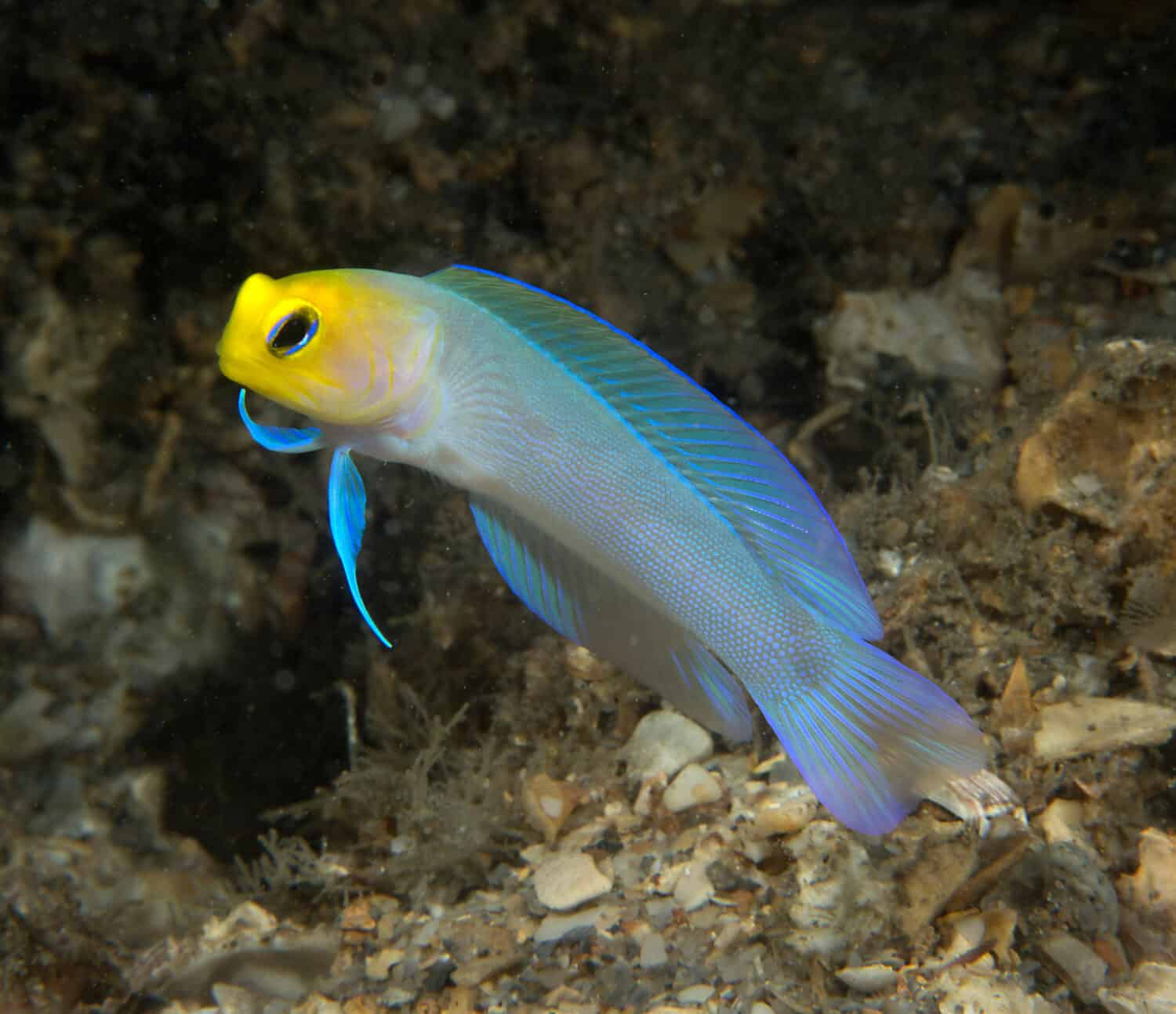
Jawfish are curious creatures that inhabit coral reefs in tropical waters and are native to the Caribbean Sea. These fish dig burrows in sandy substrates and dwell within them.
©gary powell/Shutterstock.com
Jellynose Fish (Ijimaia plicatellus)
The Jellynose Fish’s scientific name is Ijimaia plicatellus. With a long snout adorned in sensory pores, they navigate the abyssal plains of the eastern central Pacific Ocean. Moreover, their bland appearance aids in camouflage, concealing them from predators. This species resembles that of a mix between an eel and a common catfish. Jellynose Fish thrive in cold, dark waters and is an example of the resilience of life in the depths of the ocean. Furthermore, their unique adaptations offer a glimpse into the mysteries of the deep-sea ecosystem, reminding us of the beauty that dwells in the underwater world.
Jelly Bean Tetra (Ladigesia roloffi)
Next on our list of fish that start with J is the vibrant Jelly Bean Tetra or Ladigesia roloffi. It is a gem among freshwater fish in Africa. Moreover, this critically endangered species, with its petite size and translucent, vibrant neon colors, make it a sought-after aquarium resident. Furthermore, their lively demeanor and dynamic hues brighten up aquatic settings, adding a touch of charm. Schooling in groups, they create a harmonious spectacle reflecting nature’s design’s beauty. In the aquarium setting, they prefer the company of their species but can coexist with other fish species.
Jewelfish (Hemichromis bimaculatus)
In Africa resides the Jewelfish, scientifically labeled Hemichromis bimaculatus. A true jewel among aquatic creatures, their iridescent scales glisten like precious gems under the sun. Moreover, these fish are red with fine “jewel-like” blue spots across their bodies. Found in freshwater rivers and lakes, they’re known for their territorial behavior and striking appearance. Jewelfish are omnivorous. They feed on weeds, algae, certain plants, insects, crustaceans, and Caridina. Furthermore, they can be aggressive, making them unsuitable for typical community aquariums.

The Jewelfish is red with fine “jewel-like” blue spots across their bodies.
©Grigorev Mikhail/Shutterstock.com
Jewel Tetra (Hyphessobrycon eques)
The Jewel Tetra’s scientific name is Hyphessobrycon eques. It is a tropical freshwater fish native to the Amazon River drainage in South America. It prefers slow-moving water within ponds, small lakes, and streams. This species has a distinctive coloring, including a red body and a black spot near its gills. They are also omnivorous, feeding on flakes and blood worms. Moreover, their shimmering colors and elegant fins bring an air of excitement to their freshwater habitats or aquariums. They are most often swimming in schools or groups. They are unique in the way that they swim. Furthermore, these fish swim in a ‘sputtering’ or ‘twitching’ style, moving in relatively short spurts.
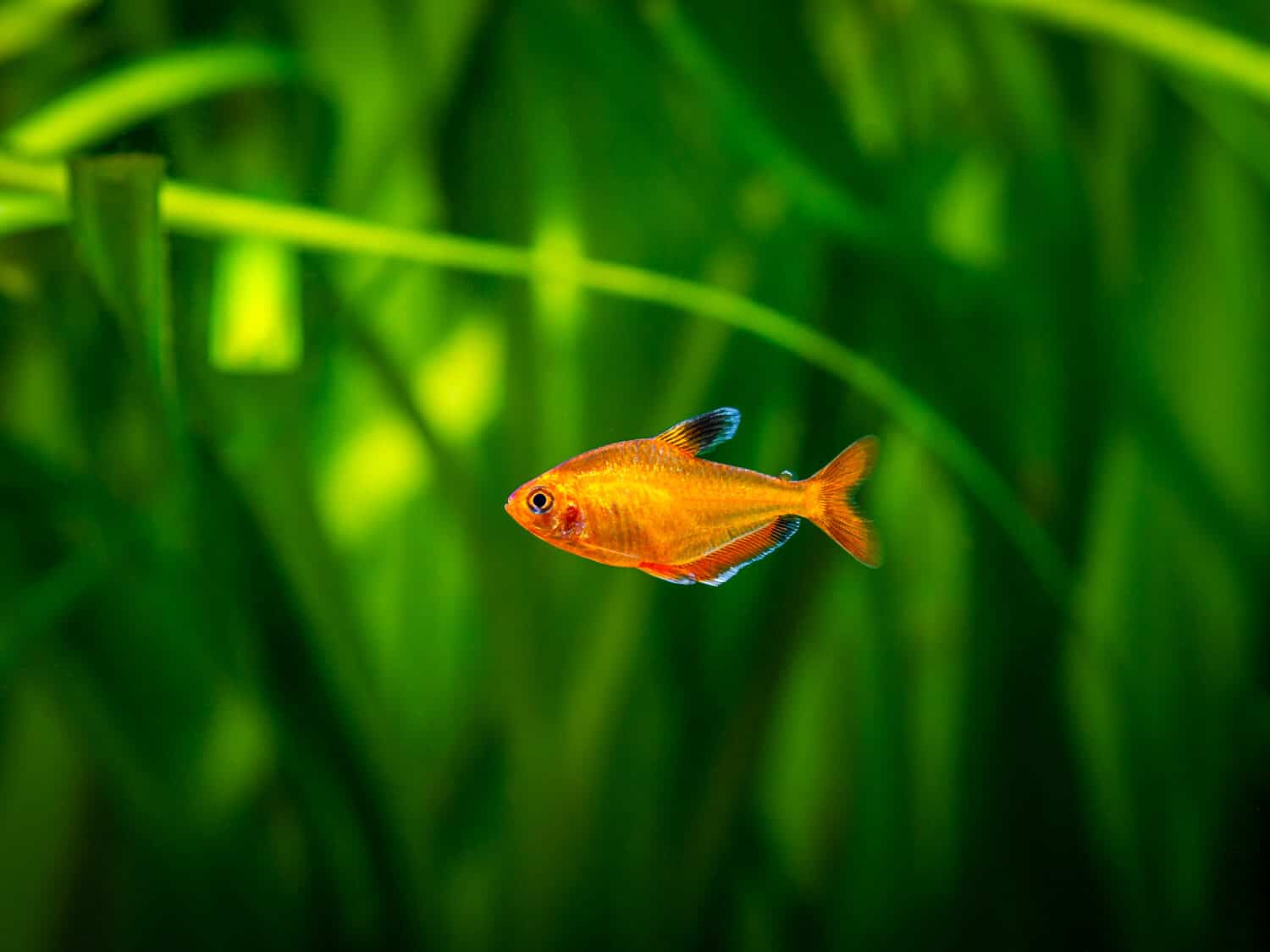
The Jewel Tetra is a tropical freshwater fish native to the Amazon River drainage in South America. They prefer slow-moving water.
©Joan Carles Juarez/Shutterstock.com
John Dory (Zeus faber)
John Dory’s scientific name is Zeus faber. This species is widespread across the coasts of Africa, South East Asia, New Zealand, Australia, Japan, and Europe. Furthermore, they live near the seabed, sometimes at considerable depths. John Dory fish use their stealth to stalk their prey, primarily consisting of smaller fish, squid, and cuttlefish. Sporting a distinctive appearance with its flat body and dark spot resembling an eye, it inspires myths and tales of maritime lore. Their delicate white flesh also makes them a prized catch for seafood enthusiasts.

The John Dory has delicate white flesh that tastes slightly sweet and nutty.
©iliuta goean/Shutterstock.com
Julii Cory (Corydoras julii)
Another fish on our list of fish that start with J is the Julii Cory, scientifically known as Corydoras julii. These small catfish sport captivating patterns reminiscent of delicate lacework. Originating from the waters of Brazil, they inhabit freshwater streams and rivers. Its body is a translucent whitish-gray color with fine black spotting. Moreover, their unique appearance grants them the nickname “Leopard Cory.” Julii Cory are peaceful bottom-dwellers that have a social behavior within aquariums. Furthermore, they primarily feed on small invertebrates.
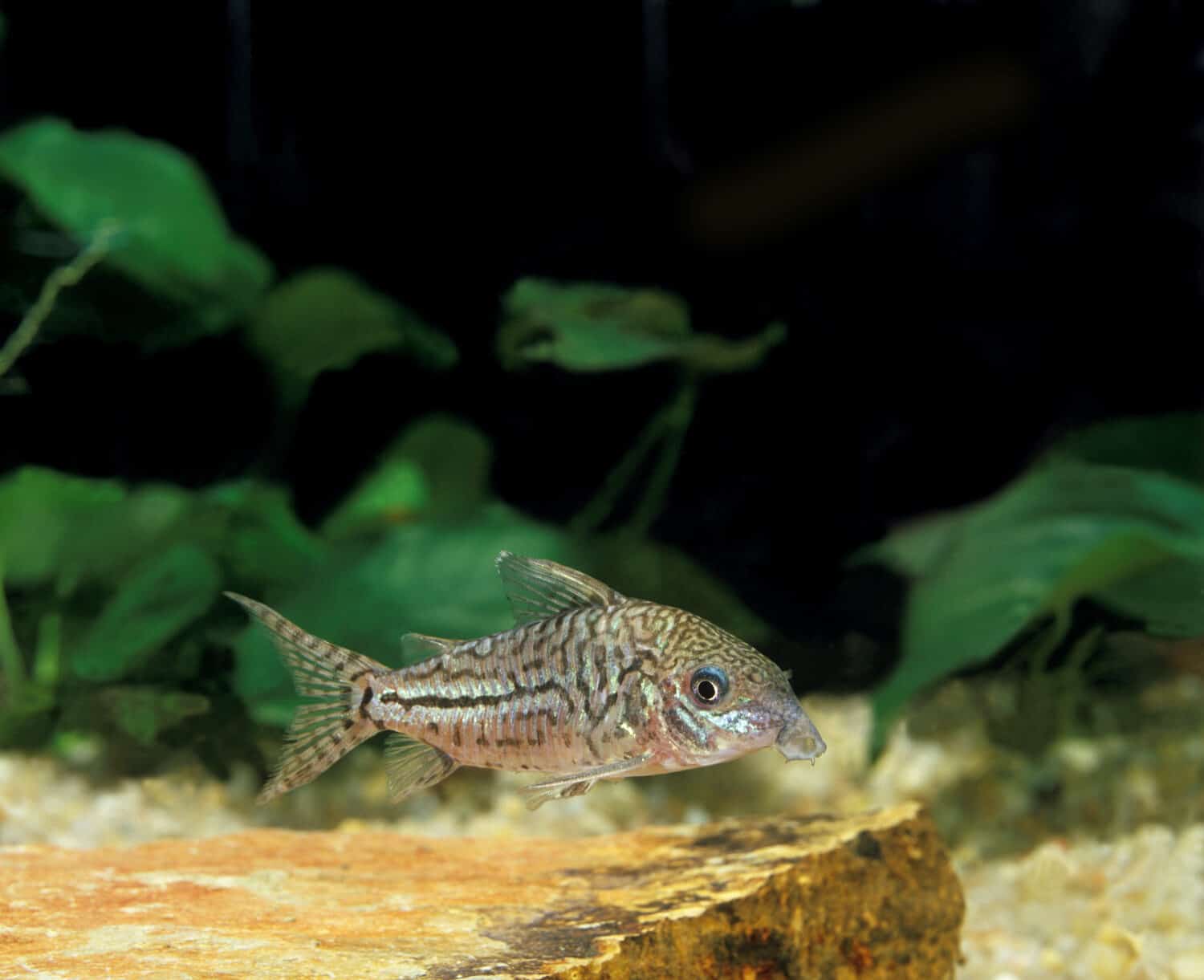
The Julii Cory, also known as the Leopard Cory, is native to the waters of Brazil, where they inhabit freshwater streams and rivers.
©slowmotiongli/Shutterstock.com
Jumping Tetra (Copella arnoldi)
The Jumping Tetra’s scientific name is Copella arnoldi. It is a slender and small tropical freshwater fish. Native to tropical river basins in South America, they reside near the water’s surface. Furthermore, their body colors consist of olive green to brown with a white belly. Most of their diet consists of worms, crustaceans, and other invertebrates, particularly small insects found on the water’s surface. Jumping Tetras lay their eggs above the waterline on leaves or other surfaces. Males care for the eggs by repeatably splashing them with water until they hatch 36 to 72 hours later.

Jumping Tetra are native to tropical river basins in South America.
©boban_nz/Shutterstock.com
Jordan’s Catfish (Arius seemani)
The Jordan Catfish’s scientific name is Arius seemani. This fish is a species of sea catfish. Moreover, with an elongated body and powerful pectoral fins, they navigate their habitats. This species is native to native to Pacific-draining rivers and estuaries, specifically in Central America and South America. They have a sleek appearance and prominent barbels. Moreover, they are skilled predators, using their sensory whiskers to locate prey. Jordan’s Catfish do not make good aquarium fish because as they mature, they must be acclimated from freshwater to saltwater.
Johanni Cichlid (Melanochromis johannii)
The Johanni Cichlid’s scientific name is Melanochromis johannii. Males sport a bold blue hue and contrasting black markings, while females and juveniles sport a golden-orange coloring. Females also have a large contrasting black strip marking. This species is an example of nature’s vivid diversity. Moreover, this small fish can live up to 12 years. Native to the rocky shallows of Lake Malawi in Africa, they are active swimmers and engage in intriguing territorial behavior. Furthermore, their diet comprises zooplankton, small invertebrates, algae, insect larvae, nymphs, crustaceans, snails, and mites.

Male Johanni Cichlids are a blue hue, while female Johanni Cichlids are a yellow hue.
©Roman Marusew/Shutterstock.com
The Largest Fish That Starts With J
Jewfish (Epinephelus itajara)
Last on our list of fish that start with J is the mammoth Jewfish, scientifically referred to as Epinephelus itajara. Their colossal size ranks them among the largest predators in coral reefs and coastal waters. This species is also the largest fish that start with J. They reside in the West Atlantic, East Atlantic, the Caribbean Sea, and the East Pacific. Found across warm tropical oceans, they command respect with their powerful presence. Moreover, these fish can grow to lengths of 8.2 feet (2.5 meters) and weigh upwards of 800 pounds (363 kilograms). Their colors range from brownish yellow to grey and green, with tiny black dots on the head, body, and fins. Furthermore, they are considered a vulnerable species on the IUCN Red List. This highlights the need to protect these magnificent creatures, showcasing the fragile nature of marine ecosystems and the vital role they play.

Jewfish are the largest species on our list of fish that start with J.
©Jesus Cobaleda/Shutterstock.com
List of Fish That Start With J
| Common Name | Scientific Name |
|---|---|
| Jack | Carangoides bartholomaei |
| Jackfish | Caranx hippos |
| Jack Dempsey | Rocio octofasciata |
| Jae Barb | Barbus jae |
| Jaguar Cichlid | Cichlasoma managuense |
| Jaguar Catfish | Liosomadoras oncinus |
| Janssens’ Barb | Barbus janssensi |
| Japanese Eel | Anguilla japonica |
| Jau Catfish | Zungaro zungaro |
| Javelin | Coelorinchus australis |
| Jawfish | Opistognathus aurifrons |
| Jellynose Fish | Ijimaia plicatellus |
| Jelly Bean Tetra | Ladigesia roloffi |
| Jewelfish | Hemichromis bimaculatus |
| Jewel tetra | Hyphessobrycon eques |
| Jewfish | Epinephelus itajara |
| John Dory | Zeus faber |
| Julii Corydoras | Corydoras julii |
| Jumping Tetra | Copella arnoldi |
| Jordan’s Catfish | Arius seemani |
| Johanni Mbuna | Melanochromis johanni |
Conclusion
Diving into the aquatic realm, we’ve unveiled a captivating collection of fish that start with J. From the depths of the ocean to the tranquil waters of freshwater habitats, these creatures embody the diversity and wonder of aquatic life. Among them, the Jewfish stands as a colossal giant weighing upwards of 800 pounds, reigning as one of the largest fish to start with J. This majestic predator resides in warm tropical oceans.
Furthermore, each of these fish, with their unique characteristics, reminds us of the incredible tapestry of life that thrives beneath the water’s surface. They invite us to explore the hidden wonders of our planet’s waters and appreciate the delicate balance that sustains underwater ecosystems. From the enigmatic depths of the ocean to the shimmering shallows of streams and ponds, these fish contribute to the captivating biodiversity of our Earth.
The photo featured at the top of this post is © raditya/Shutterstock.com
Thank you for reading! Have some feedback for us? Contact the AZ Animals editorial team.







